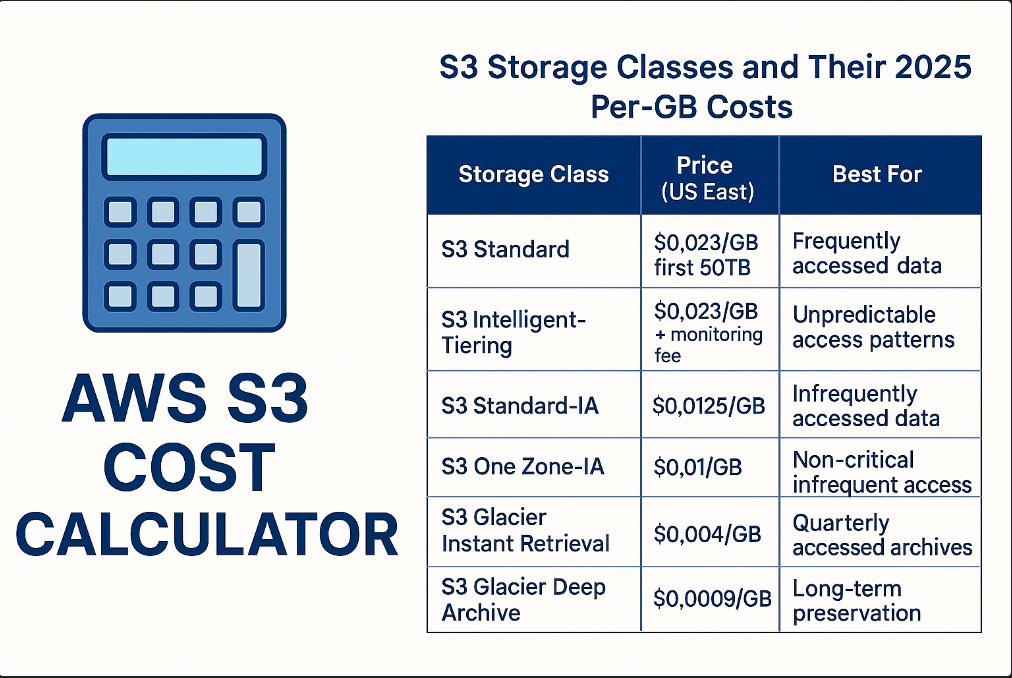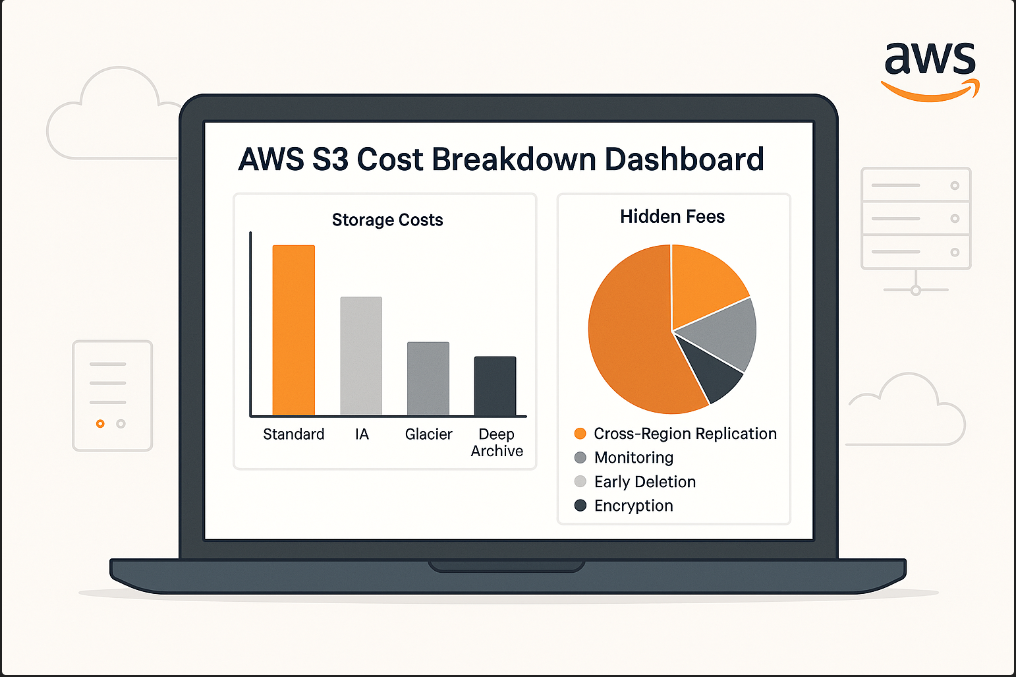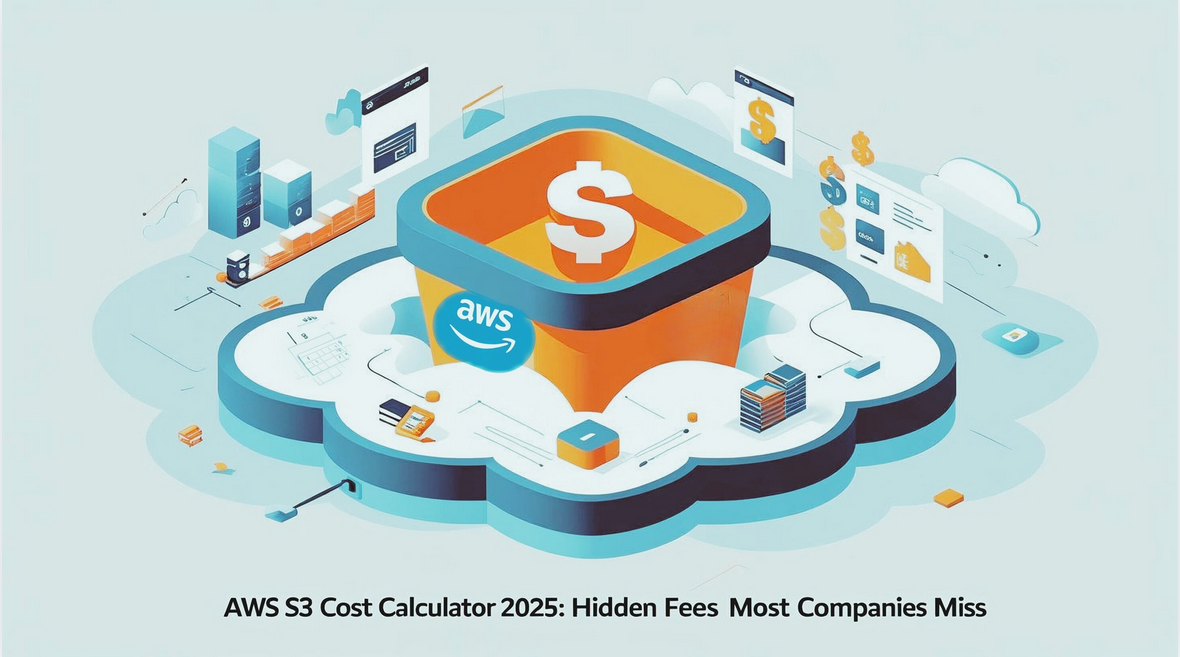Did you know that AWS S3 can save you up to 82% on your storage costs with Intelligent-Tiering, yet most companies miss out on these savings?
Here’s the brutal truth: Amazon S3 stands as one of the most versatile and cost-effective ways to store data in the cloud, offering simple key-based object storage for any type of data. However, while S3’s pricing appears straightforward—you only pay for resources you’ve actually used—costs can quickly escalate when storing and transferring large volumes of data.
After analyzing hundreds of AWS bills, we’ve seen companies paying 3-5x more than necessary for S3 storage. The biggest culprit? Hidden fees and poor storage class selection.
💡 Real example: One client reduced their monthly S3 bill from $23,000 to $8,500 simply by implementing proper lifecycle rules and storage class optimization.
Understanding the aws s3 cost calculator tools and aws s3 cost estimator features becomes crucial when planning your cloud budget. Additionally, properly estimating your aws s3 storage cost requires knowledge of specific pricing elements like retrieval fees ($0.01 per GB for Infrequent Access data) and monitoring charges ($0.0025 per 1,000 objects monthly).
Understanding AWS S3 Bucket Pricing in 2025
Amazon S3 pricing operates on a pay-as-you-go model where multiple cost components work together to determine your final bill. Understanding these components is essential for accurate budgeting and cost optimization.
S3 Storage Classes and Their 2025 Per-GB Costs

The storage class you select significantly impacts your aws s3 storage cost. Each class serves different access patterns and has distinct pricing structures. As of 2025, here’s what you need to know:
| Storage Class | Price (US East) | Best For |
|---|---|---|
| S3 Standard | $0.023/GB first 50TB |
Frequently accessed data |
| S3 Intelligent-Tiering | $0.023/GB + monitoring fee |
Unpredictable access patterns |
| S3 Standard-IA | $0.0125/GB |
Infrequently accessed data |
| S3 One Zone-IA | $0.01/GB |
Non-critical infrequent access |
| S3 Express One Zone | $0.11/GB |
Ultra-low latency access |
| S3 Glacier Instant Retrieval | $0.004/GB |
Quarterly accessed archives |
| S3 Glacier Flexible Retrieval | $0.0036/GB |
Rarely accessed archives |
| S3 Glacier Deep Archive | $0.00099/GB |
Long-term preservation |
💡 2025 Update: S3 Express One Zone has seen significant price reductions—storage costs down by 31%, PUT requests by 55%, and GET requests by 85%.
Request Costs: PUT, GET, LIST, DELETE Pricing
Beyond storage, S3 charges for API operations performed on your objects. These request costs typically account for approximately 15% of total S3 spend. Here’s what you’re paying:
- PUT, COPY, POST, LIST: $0.005 per 1,000 requests
- GET, SELECT: $0.0004 per 1,000 requests
- Lifecycle transitions: $0.01 per 1,000 requests
- DELETE and CANCEL: Free across all storage classes
⚠️ Hidden cost alert: Simply browsing your S3 buckets through the AWS console generates billable GET and LIST requests.
Data Transfer Charges Across Regions and Internet
Data transfer pricing follows these key principles:
| Transfer Type | Cost | Notes |
|---|---|---|
| Inbound to S3 from internet | Free | Always free |
| First 100GB/month outbound | Free | Per AWS account |
| Outbound to internet (first 10TB) | $0.09/GB |
Decreases with volume |
| Between S3 buckets (same region) | Free | Always free |
| Cross-region transfers | $0.02/GB |
Between most regions |
Hidden AWS S3 Fees Most Companies Overlook

Beyond the standard pricing components, several hidden costs can unexpectedly inflate your aws s3 cost. Let’s examine these overlooked fees that could significantly impact your cloud budget in 2025.
Early Deletion Fees in Glacier and Deep Archive
Many organizations miss the minimum storage duration requirements when using cold storage options:
- S3 Glacier Flexible Retrieval: 90-day minimum commitment
- S3 Glacier Deep Archive: 180-day minimum commitment
Deleting objects before these periods triggers pro-rated charges for the remaining days.
💸 Real cost example: Delete a 2.5TB file from Glacier Deep Archive after just one day? You’ll still pay $4.54 for the remaining 179 days: 2522.5GB × $0.00180 × (180 days – 1 day) / 180 days = $4.54
Monitoring Charges in Intelligent-Tiering
Despite its cost-saving potential, S3 Intelligent-Tiering includes a monitoring fee that catches many organizations off guard:
- Cost: $0.0025 per 1,000 objects monitored monthly
- Applies to: Objects larger than 128KB only
- Small objects: Still pay Frequent Access tier rates without auto-tiering benefits
⚠️ Cost shock example: 750 million objects eligible for monitoring = $1,875 monthly in monitoring fees alone:
(750,000,000 × $0.0025) / 1,000 = $1,875
Cross-Region Replication and Transfer Costs
Cross-Region Replication (CRR) involves multiple hidden expenses beyond standard storage costs. For every 100GB replicated between regions, you’ll pay approximately:
| Cost Component | Amount (100GB) | Percentage |
|---|---|---|
| Source region storage | $2.30 | 35% |
| Destination region storage | $2.30 | 35% |
| Data transfer | $2.00 | 30% |
| Total | $6.60 | 100% |
KMS Encryption Overhead with S3 Bucket Keys
Server-side encryption with KMS keys introduces substantial API costs that many users overlook. Without S3 Bucket Keys enabled, each encrypted object requires individual KMS API calls.
💰 Success story: One organization reduced their KMS costs from $1,500 to $300 daily simply by implementing S3 Bucket Keys—a 99% reduction in KMS request costs.
Using the AWS S3 Cost Calculator and Estimator Tools
Planning your AWS S3 costs requires reliable estimation tools that account for all pricing components discussed earlier. Accurately forecasting expenses helps prevent budget surprises and optimizes cloud spending.
How to Use the AWS S3 Cost Calculator Step-by-Step
The AWS Pricing Calculator is accessible through a web-based console at calculator.aws with no APIs currently available. To create an estimate:
- Navigate to the landing page
Click “Create estimate” to begin - Add S3 Service
Filter for S3 or search by keywords
Select “Configure” next to Amazon S3 - Configure Basic Settings
Choose your AWS Region (prices vary by location)
Input storage volume estimates in GB - Specify Usage Patterns
Define request types and volumes (PUT, GET, LIST)
Configure data transfer requirements - Review and Save
Review your estimate and add to cart
Save for future reference or sharing
🌏 China Region note: For China Region estimates, use the separate calculator at calculator.amazonaws.cn
Limitations of the AWS S3 Cost Estimator
Be aware of these important limitations when using the cost calculator:
- Estimates vs. Reality: Approximations only—actual costs may differ
- No Free Tier: Doesn’t account for Free Tier pricing or promotional credits
- Time Assumptions: Assumes 730 hours per month (365 days × 24 hours ÷ 12 months)
- 12-Month Limit: Only shows estimated totals up to the first 12 months
- Currency: Estimates are in U.S. dollars only
Real-World Example: Monthly Cost Breakdown
Consider this sample calculation for hosting video content:
Scenario: 1,000 viewers watching a one-hour SD-540p live event
| Component | Details | Cost (USD) |
|---|---|---|
| Storage | S3 Standard (21 segments × 4 bitrates) | $0.01 |
| Requests | 7,200 PUT requests (segments + manifests) | $0.04 |
| Distribution | CloudFront delivery to 1,000 viewers | $67.24 |
| Total | $67.29 |
This example illustrates how smaller storage costs ($0.05) can be dwarfed by distribution expenses ($67.24) when serving content to multiple users.
Top 5 AWS S3 Cost Optimization Tips for 2025
Slashing your aws s3 cost requires more than just price awareness—it demands strategic optimization techniques. Let’s explore five powerful methods to reduce S3 expenses in 2025.
1. Set Lifecycle Rules to Transition or Delete Objects
Implement S3 Lifecycle rules to automatically manage your data’s complete lifecycle. This is the single most impactful optimization you can make.
Recommended Lifecycle Strategy:
- Day 0-30: S3 Standard for frequently accessed data
- Day 30-90: Transition to S3 Standard-IA (46% savings)
- Day 90+: Move to S3 Glacier Flexible Retrieval (84% savings)
- Archive data: S3 Glacier Deep Archive (96% savings)
Additionally, configure expiration rules for noncurrent versions to prevent storage bloat when versioning is enabled. Organizations implementing these rules typically see 40% annual savings.
2. Enable S3 Intelligent-Tiering for Unpredictable Access
For data with unknown or changing access patterns, S3 Intelligent-Tiering delivers automatic storage savings by moving objects between access tiers based on usage.
💰 Proven savings: Since its 2018 launch, this feature has saved customers more than $4 billion compared to S3 Standard.
- 30 days: Move to Infrequent Access tier (40% savings)
- 90 days: Move to Archive Instant Access (68% savings)
- Objects < 128KB: Remain in Frequent Access tier (no monitoring charges)
3. Compress and Batch Upload Small Files
Small objects create disproportionate overhead costs. Each file requires milliseconds to open, read metadata, and close—multiplied across millions of files, these operations significantly impact performance and costs.
Best practices for small files:
- Batch files under 1MB together in archives (TAR, ZIP, tar.gz)
- Compress before uploading to reduce storage costs
- Reduce API request expenses (same cost regardless of file size)
4. Align S3 Buckets with Compute Regions
Cross-region data transfers substantially increase aws s3 storage cost. Place S3 buckets in the same region as your compute resources whenever possible.
| Scenario | Cost | Monthly Impact (1TB) |
|---|---|---|
| Same region transfers | Free | $0 |
| Cross-region transfers | $0.02/GB | $20 |
For unavoidable multi-region scenarios, consider using S3 Multi-Region Access Points to optimize access patterns and minimize unnecessary data movement costs.
5. Use S3 Storage Lens to Identify Cost Drivers
Leverage S3 Storage Lens to gain organization-wide visibility into storage usage trends and identify cost-saving opportunities. This built-in analytics feature helps detect:
- Incomplete multipart uploads older than 7 days
- Excessive noncurrent versions eating up storage
- Missing lifecycle rules on active buckets
- Cold buckets with low retrieval rates (perfect for archival)
🎯 Pro tip: With advanced metrics enabled, companies can prioritize optimization efforts where they’ll have the greatest financial impact—often identifying 30-50% potential savings.
Real-World S3 Cost Calculation Walkthrough
To demonstrate how aws s3 cost factors interact in practice, let’s analyze a realistic storage scenario and calculate actual expenses.
Scenario: 1TB Data with Mixed Access Patterns
For our calculation, imagine a company storing 1TB (1,000GB) of data with the following access distribution:
- 30% frequently accessed (product images, current documents)
- 30% infrequently accessed (quarterly reports, older media)
- 40% rarely accessed (archives, compliance data)
This access pattern mirrors typical business usage where data naturally becomes “colder” over time.
Cost Breakdown by Storage Class and Region
Let’s examine monthly costs in US East (N. Virginia) for this 1TB across different storage approaches:
| Storage Approach | Calculation | Monthly Cost | Savings |
|---|---|---|---|
| All in S3 Standard | 1,000GB × $0.023 |
$23.00 | Baseline |
| Class-Optimized | (300GB × $0.023) + (300GB × $0.0125) + (400GB × $0.004) |
$11.15 | 51% savings |
| Intelligent-Tiering | Storage + Monitoring (1,000,000 objects) | $15.90 | 31% savings |
Impact of Lifecycle Policies on Monthly Bill
When implementing lifecycle policies, the first month typically shows higher costs due to transition charges. However, strategic transitions between storage classes can reduce expenses by approximately 40% annually.
📊 Real results: Organizations implementing lifecycle policies typically see ROI within 60 days and achieve sustained 40% cost reductions compared to keeping everything in S3 Standard.
Savings from Intelligent-Tiering vs Standard
Initially, Intelligent-Tiering appears more expensive than Standard storage due to monitoring fees ($0.0025 per 1,000 objects). However:
- Month 2: 30% of objects move to Infrequent Access tier
- Month 4: 40% move to Archive Instant Access tier
- Result: 30-60% cost reductions per terabyte
AWS S3 Cost Calculator – Frequently Asked Questions
You can use the AWS S3 Cost Calculator to identify ways to reduce S3 costs by setting up lifecycle rules to move data to cheaper storage tiers, using S3 Intelligent-Tiering for unpredictable access patterns, compressing and batching small files, aligning S3 buckets with compute regions, and leveraging S3 Storage Lens to spot cost-saving opportunities.
The AWS S3 Cost Calculator can reveal hidden AWS S3 fees that many companies miss, such as early deletion charges for Glacier storage (90–180 day minimums), Intelligent-Tiering monitoring fees ($0.0025 per 1,000 objects), cross-region replication charges, KMS encryption overhead, and costs from unoptimized versioning or incomplete multipart uploads.
S3 Intelligent-Tiering, as shown in the AWS S3 Cost Calculator, automatically moves objects between tiers based on usage patterns. Despite its monitoring fee, it has saved customers over $4 billion and can reduce AWS S3 storage costs by 30–60% for fluctuating workloads.
When using the AWS S3 Cost Calculator, consider storage volume, data transfer out, request quantity, region selection, and storage class choice. Be aware that the calculator doesn’t include Free Tier pricing or projections beyond 12 months.
Lifecycle policies can reduce AWS S3 storage costs by up to 40% annually, and the AWS S3 Cost Calculator can model these savings. They automatically move objects to lower-cost tiers over time, optimizing costs for data with changing access patterns.
The AWS S3 Cost Calculator shows that S3 Standard costs $0.023/GB, Standard-IA costs $0.0125/GB, Glacier Instant Retrieval costs $0.004/GB, and Glacier Deep Archive costs $0.00099/GB. Choosing the right class can drastically lower AWS S3 pricing.
Yes — the AWS S3 Cost Calculator factors in 90-day minimums for Glacier Flexible Retrieval and 180-day minimums for Glacier Deep Archive. Early deletions incur pro-rated charges.
The AWS S3 Cost Calculator estimates cross-region replication costs, which include source and destination storage plus transfer fees. For 100GB, expect around $6.60 in total.
The AWS S3 Cost Calculator shows that PUT/COPY/POST/LIST requests cost $0.005 per 1,000 and GET requests cost $0.0004 per 1,000. Minimizing requests can lower AWS S3 pricing significantly.
According to the AWS S3 Cost Calculator, US East (N. Virginia) offers the lowest S3 pricing at $0.023/GB, while some Asia Pacific regions can cost 20–30% more.
The AWS S3 Cost Calculator highlights that versioning can multiply storage costs since each version is billed separately. Lifecycle rules can help remove old versions and lower costs.
Data transfer in is free, but the AWS S3 Cost Calculator shows that transfer out beyond 100GB/month costs $0.09/GB for the first 10TB, with extra charges for cross-region transfers.
The AWS S3 Cost Calculator can model the impact of KMS costs. Without S3 Bucket Keys, KMS API calls can be expensive, but enabling them can reduce costs by up to 99%.
S3 Storage Lens can reveal savings of 30–50%, and the AWS S3 Cost Calculator can estimate these benefits after cleanup of unused or incomplete uploads.
The AWS S3 Cost Calculator recommends Glacier Deep Archive at $0.00099/GB for long-term archives, offering 96% savings over Standard.
The AWS S3 Cost Calculator includes costs for incomplete multipart uploads, which continue to accrue charges until deleted.
The AWS S3 Cost Calculator includes the $0.0025 per 1,000 objects monitoring fee for Intelligent-Tiering, applied only to objects over 128KB.
The AWS S3 Cost Calculator shows S3 Express One Zone at $0.11/GB, with reduced request costs in 2025 making it ideal for ultra-low latency workloads.
The AWS S3 Cost Calculator shows One Zone-IA at $0.01/GB vs Standard-IA at $0.0125/GB, a 20% saving for non-critical data.
The AWS S3 Cost Calculator reveals that batching small files can significantly reduce storage and request costs.
The AWS S3 Cost Calculator lists Glacier retrieval fees and times, helping you choose the most cost-efficient option.
The AWS S3 Cost Calculator helps project monthly costs based on storage, requests, transfers, and lifecycle policies.
The AWS S3 Cost Calculator factors in the updated 6-month $100 credit system as of July 2025.
The AWS S3 Cost Calculator can model savings of 50%+ by selecting the right mix of storage classes.
The AWS S3 Cost Calculator estimates Transfer Acceleration costs of $0.04–$0.08 per GB in addition to normal transfer fees.
Conclusion: Mastering S3 Costs for Maximum Value
Understanding the intricacies of AWS S3 pricing ultimately determines whether your cloud storage costs remain manageable or spiral out of control. Throughout this guide, we’ve explored the multifaceted components that constitute your aws s3 cost, from storage classes and request pricing to the often-overlooked hidden fees that can significantly impact your budget.
The key takeaway is clear: selecting the appropriate storage class for your data access patterns stands as the most impactful decision you’ll make. The difference between storing all data in S3 Standard versus strategically distributing it across Standard, Standard-IA, and Glacier can reduce your monthly bill by over 50%, as demonstrated in our calculations.
Your S3 Cost Optimization Action Plan:
- Week 1: Audit current storage classes and identify optimization opportunities
- Week 2: Implement lifecycle rules for automatic tiering
- Week 3: Enable S3 Intelligent-Tiering for unpredictable workloads
- Week 4: Set up S3 Storage Lens monitoring and clean up incomplete uploads
Remember the hidden costs we’ve uncovered: early deletion fees in Glacier storage, monitoring charges in Intelligent-Tiering, cross-region replication expenses, and KMS encryption overhead can transform an apparently reasonable storage plan into a budget nightmare if left unmonitored.
The AWS S3 Cost Calculator helps predict these expenses before implementation, though its limitations require careful consideration. Remember that actual costs may differ from estimates, particularly when workloads change dynamically.
The bottom line: AWS S3 remains one of the most versatile and cost-effective cloud storage solutions available today. However, maximizing its value requires understanding all pricing nuances and implementing targeted optimization techniques. With the knowledge and strategies presented in this guide, you’re now equipped to make informed decisions that balance performance requirements with budget constraints for your organization’s cloud storage needs.
Ready to Optimize Your S3 Costs?
Get a comprehensive analysis of your AWS S3 spending and discover hidden savings opportunities.
Try CostQ Free and optimize your S3 costs with automated recommendations—no credit card required.
Join 500+ companies already saving with intelligent cloud cost optimization.
